Part I -- To Russia With Love
One description TRT heard of St. Petersburg, the day before departing, was that it was 'just another industrial town' -- a JAIT. Now, this view came second-hand from an engineer who heard it from another engineer. TRT suspects it was one of those Baltic cruise ship adventures.
The cruise ships (there are many) stop at a special port, where certain arrangements have been made for the captive customers. We never saw that port, just the airport, but that'll do, thank-you A lot of St. Petersburg looks industrial, but then so do parts of Paris and London.
 TRT has visited a few JAITs but can't recall any of them having quite as many palaces as St. Petersburg. We visited only two inside: the Winter Palace (above) and the Yusopov Palace (below).
TRT has visited a few JAITs but can't recall any of them having quite as many palaces as St. Petersburg. We visited only two inside: the Winter Palace (above) and the Yusopov Palace (below).
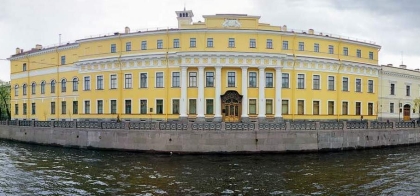
It soon overwhelms. After a couple of days you find yourself thinking Just Another Palace (JAP) or Just Another Church (JAC), like you're some kind of imperial figure who can pass judgment with a mere glance and declare which is the best; like the Pope, a Tsar, or Stephen Harper.
JAP and JAC syndrome are hazards to be aware of when visiting St. Petersburg.
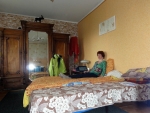 A Room With a View
A Room With a View
For the first two weeks MLW, our intrepid traveler, was billeted in the master bedroom in an 14 story apartment in a large apartment complex. Her room was comfortable and eclectically furnished -- gezellig in Dutch.
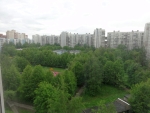
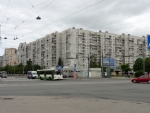 There are many large apartment blocks surround- ing St. Petersburg, most of them quite drab and shabby looking.
There are many large apartment blocks surround- ing St. Petersburg, most of them quite drab and shabby looking.
For the last week, we stayed in two different mini-hotels (a hotel with maybe 4 or 5 available rooms) closer to the city center. The mini-hotels, run by the same proprietor, are in buildings called, respectively, Austrian Yard II and Austrian Yard, on a street named Furshtatskya ulitsa. The first is is across the street from the US consulate.
The Austrian Yard Mini Hotel had kitchenette rooms. It was next door to the German consulate and (apparently) across the street from the Austrian consulate.
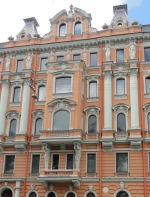
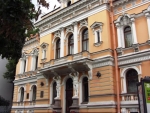 The hotels were separated by a short walk down a wide avenue that has a pedestrian promenade in the center with benches and trees on both sides. On both sides of the promenade is a one way street with lots of parking allocated but precious little available. Think Paris.
The hotels were separated by a short walk down a wide avenue that has a pedestrian promenade in the center with benches and trees on both sides. On both sides of the promenade is a one way street with lots of parking allocated but precious little available. Think Paris.
There are many pretty buildings and apartments, old and ornate. Some are decrepit, some are restored. There are 24 hour grocery stores in the lowest levels, below sidewalk grade.
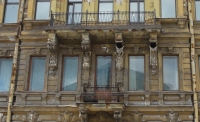 Most buildings in the area typically have a metal security gate for vehicles with a smaller door inset in the large gate for pedestrians. Beyond the gate is a courtyard with parking. There are several entrances in each courtyard to the different apartment blocks within.
Most buildings in the area typically have a metal security gate for vehicles with a smaller door inset in the large gate for pedestrians. Beyond the gate is a courtyard with parking. There are several entrances in each courtyard to the different apartment blocks within.
Both our courtyards had some posh cars parked inside. One courtyard looked like a luxury German car dealership; the other had more modest offerings; but there was a Bentley parked outside on most mornings.
There was a wedding pavilion just down the block that did a brisk trade every day that we were there. The Metro station was a little further down, at end of the block.
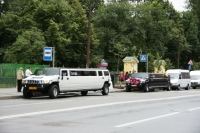 A beautiful park 'Tavricheskiy sad', was at the other end of the block. A stretch Hummer was parked on standby, in case there was a wedding breakout.
A beautiful park 'Tavricheskiy sad', was at the other end of the block. A stretch Hummer was parked on standby, in case there was a wedding breakout.
St. Petersburg has a lot of vehicles of all kinds. Mercedes and BMW's sedans seem to be the car of choice. SUV's are also popular.
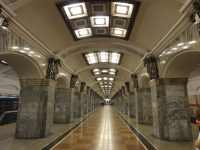 There was a curious absence of cabs for such a big city with so many cars. We used the subway system to travel around in Saint Petersburg and the bus to go beyond it.
There was a curious absence of cabs for such a big city with so many cars. We used the subway system to travel around in Saint Petersburg and the bus to go beyond it.
We really only needed a cab for the airport trips and we had drivers arranged for us by the hotel staff. Everyone we dealt with were good and gracious about service. One even refused a tip.
 We were about 4 km from Palace square, whichs fronts of the Hermitage and is the center of St. Petersburg.
We were about 4 km from Palace square, whichs fronts of the Hermitage and is the center of St. Petersburg.
Opposite the Hermitage is an impressive semi circular edifice that was once the headquarters of the KGB. In the center of square is a huge 600 ton granite column topped with a statue of an angel.
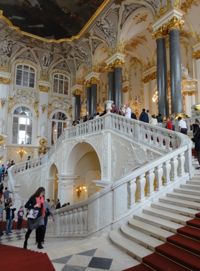 The Hermitage, which is one of the oldest and largest museums in the world, was known as the Winter Palace in the time of Catherine the Great. It was converted into a musuem in 1852 and renamed the the Sate Hermitage Museum.
The Hermitage, which is one of the oldest and largest museums in the world, was known as the Winter Palace in the time of Catherine the Great. It was converted into a musuem in 1852 and renamed the the Sate Hermitage Museum.
When one has so many palaces being built, it's hard to come up with good names. They keep it simple at first with names like the Summer Palace and Winter Palace so the tradesman don't get confused. The Winter Palace probably had the better heating system.

TRT had to queue up for 1½ hours for tickets into the Hermitage, while MLW had a coffee or two. This was slightly less time than it took to unsuccessfully purchase tickets on the 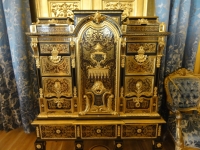 internet the previous week.
internet the previous week.
St. Petersburg is supposed to have some of the best internet programmers in Russia. Unfor- tunately none of them work for the Hermitage.
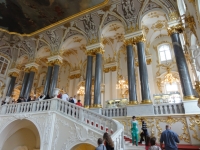 The Hermitage has many spectacular rooms to behold, with elaborate white marble staircases, granite columns, gilded ceilings and beautiful parquet floors.
The Hermitage has many spectacular rooms to behold, with elaborate white marble staircases, granite columns, gilded ceilings and beautiful parquet floors.
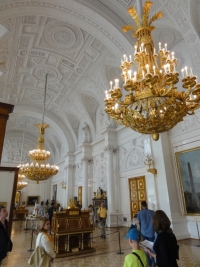
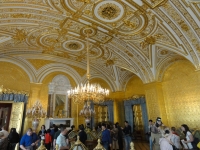
While the ceilings in many of the rooms are the first to catch the eye, I was most impressed by some of the floors in 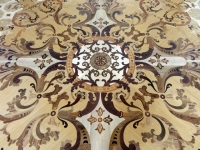 intricate patterns made from all kinds of exotic woods.
intricate patterns made from all kinds of exotic woods.
People look at the ceilings but they just walk on the floors, yet these floors are in beautiful condition. What an amazing and durable material wood can be.
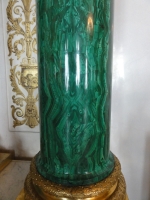 Another specialty craft loved the Russian nobility was malachite mosaic. Malachite is a rich green copper based mineral found in the Russian Urals.
Another specialty craft loved the Russian nobility was malachite mosaic. Malachite is a rich green copper based mineral found in the Russian Urals.
The mineral is cut and pieced together like a mosaic, often using reverse image symmetry to great effect. The finished piece is then polished to a high luster.
There is a Malachite room in the Hermitage that contains some outstanding examples of the craft.
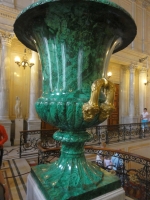 Mastering Mosaic
Mastering Mosaic
On one of our walks we stopped at the Mosaic park, a courtyard that is a community project in progress. There were a couple of Omas and a handful of kids teaching and learning the craft with broken bits of tile. pots, porcelain and whatever.
Some pieces had a color that matched with others, but the shapes were totally random. There were hammers, chisels and nipper tools available for shaping, sand and cement for setting.
We were recruited to give it a try. Sure, OK, why not.
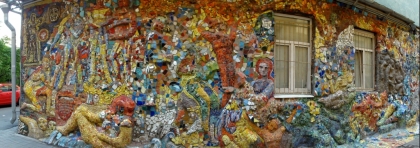
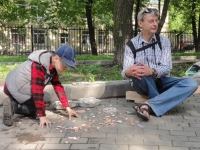 TRT discovers that it is far more difficult to create art than it looks. They were doing their best to help and encourage me but I felt like a snake learning to walk -- GET ME OUTTA HERE.
TRT discovers that it is far more difficult to create art than it looks. They were doing their best to help and encourage me but I felt like a snake learning to walk -- GET ME OUTTA HERE.
MLW persisted and eventually created something that didn't look like an accident in the kitchen. Then, with the loving 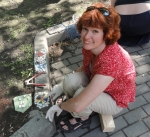 guidance of her proud Oma master, it was set in mortar.
guidance of her proud Oma master, it was set in mortar.
The event was duly recorded for posterity and MLW signed the registry. Since this is Russia, this might also be a regulation. Oma invited us to return in a couple of years to view the work again along with all the other wonderful new additions to the Mosaic Courtyard. Oma is a great ambassador for St. Petersburg.
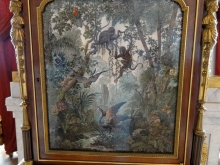 Meanwhile, back in the Malachite Room in the Hermitage, TRT is in complete awe of this cabinet with a front panel done with malachite mosaic. This photo can never do this piece justice, so you may have to visit the Hermitage yourself.
Meanwhile, back in the Malachite Room in the Hermitage, TRT is in complete awe of this cabinet with a front panel done with malachite mosaic. This photo can never do this piece justice, so you may have to visit the Hermitage yourself.
No page would be complete without a mention of the Mona Lisa of the Hermitage -- the fabled Peacock Clock. This is the work of art that all cruise ship tour groups must see after they have rushed through the Rembrandt room.
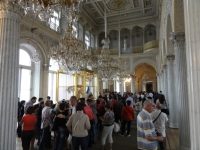 You can tell you are in The Pavilion Room, he one with the famous Peacock Clock because:
You can tell you are in The Pavilion Room, he one with the famous Peacock Clock because:
1) There are hordes of tourists looking and a few tour guides watching the time.
2) Nothing in the room resembles a clock.
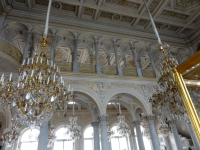
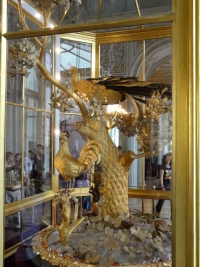 The Pavilion Room is spectacular, with large windows, crystal chandeliers and viewing galleries from above.
The Pavilion Room is spectacular, with large windows, crystal chandeliers and viewing galleries from above.
The Peacock clock is, uh, very interesting. It's a beautiful work of art; just don't expect any help from it when it comes to figuring out how much time you have before the bus leaves.
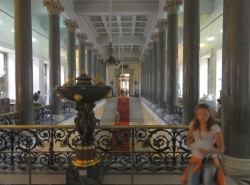 And with that note it is time to leave this place, have a beer and think about reading that tourist guidebook that we purchased for this trip. TRT is very surprised. It makes you wonder about the history.
And with that note it is time to leave this place, have a beer and think about reading that tourist guidebook that we purchased for this trip. TRT is very surprised. It makes you wonder about the history.
There are other palaces in St. Petersburg but the Winter Palace belonged to Catherine the Great, so it had to be great. Peter the Great died 37 years before Catherine the Great (no relation), age 33, became Empress of All the Russias.
In those 37 years, Russia had no less than 6 other monarchs, tsars, regents, or whatever. The males in this line of succession did not fare well; which maybe says something about the country, or just women in general. Peter III, Catherine's hubby was assassinated in a coup d'état. Catherine denied any involvement, and nothing was proven in court, but people are still talking about it.
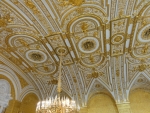 There is much more to see in the Hermitage and it is worth 2 days if you have the time and you like museums or even if you have the time, or even if you just like mueums and have no time. I digress.
There is much more to see in the Hermitage and it is worth 2 days if you have the time and you like museums or even if you have the time, or even if you just like mueums and have no time. I digress.
TRT went back to the room of the mini hotel and just stared at the ceiling, pondering what might be next.
Next: Just Another Palace





























